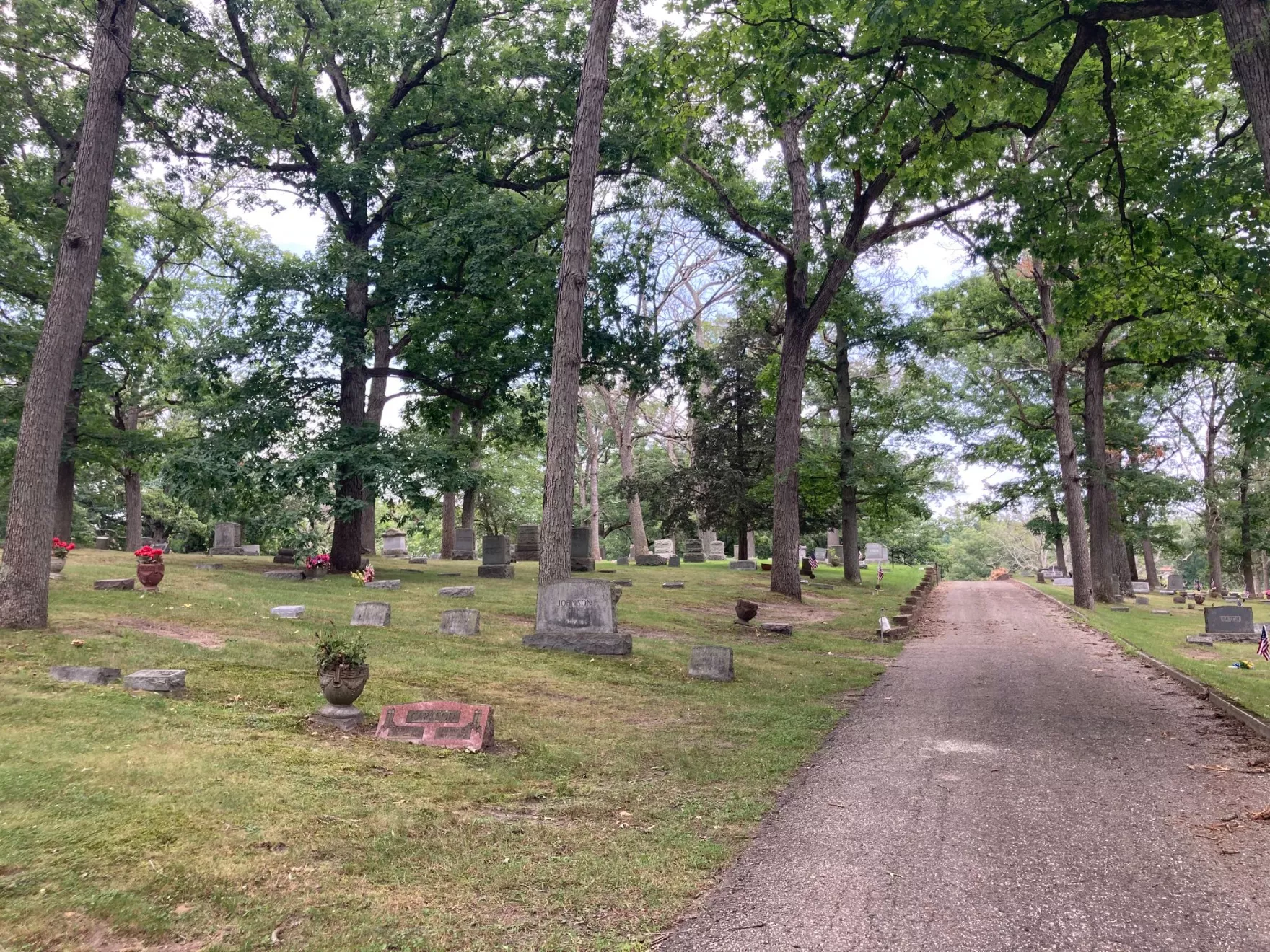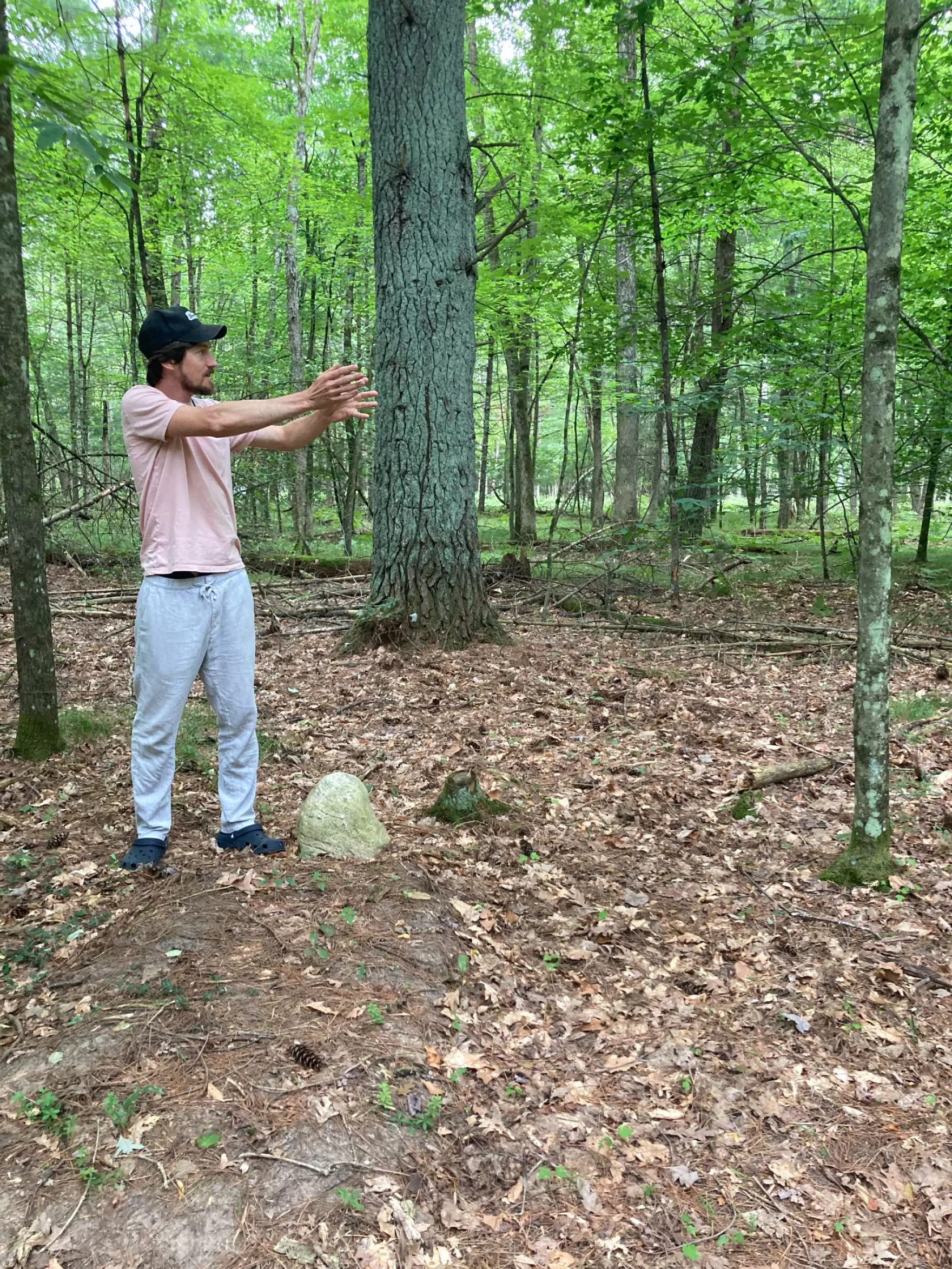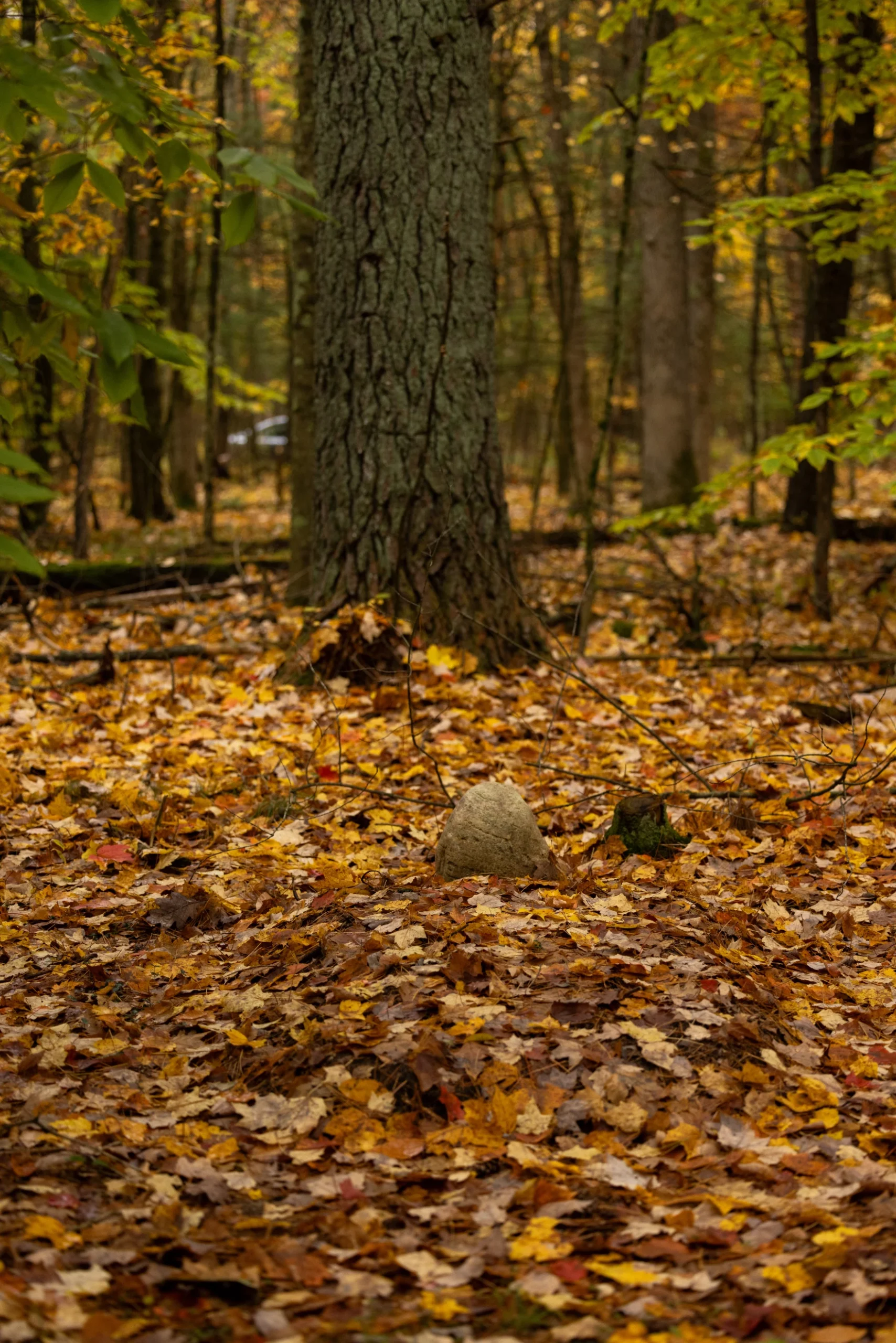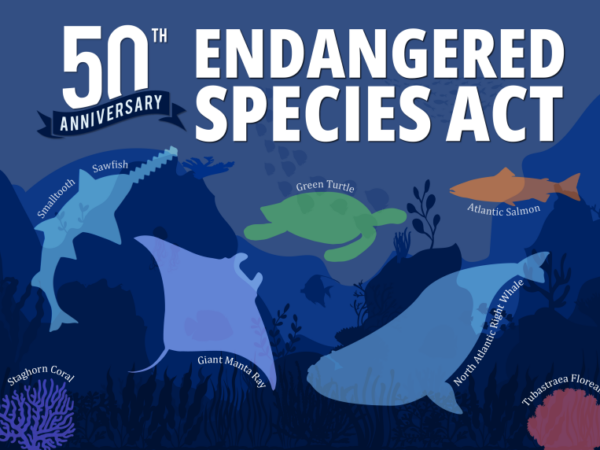
By Ellie Katz, Interlochen Public Radio
Points North is a biweekly podcast about the land, water and inhabitants of the Great Lakes.
This episode was shared here with permission from Interlochen Public Radio.
Peter Quakenbush’s big dream in life is a little different.
He wants to start a conservation burial forest. No harmful embalming fluids, no fancy caskets – just a forest preserve where people can be buried in nature.
But the closer he gets to making the burial forest happen, the harder it is. More people start getting in the way. And now he wonders: Will he ever be able to make his dream a reality?
Credits:
Producer: Ellie Katz
Host: Dan Wanschura
Editor: Morgan Springer
Additional Editing: Dan Wanschura
Music: Greyleaf Willow, Beignet, Throughput (Less Percussion), Sprig Leaf, Dowdy (1 Min), Awaiting Lady D and Greycase by Blue Dot Sessions

Green burial and conservation burial are becoming increasingly popular, partly because they’re seen as more environmentally friendly. Some studies show higher levels of contamination around old conventional cemeteries, likely leachate from vaults, caskets and embalming fluids. (Credit: Ellie Katz/Points North)
Transcript:
DAN WANSCHURA, HOST: Peter Quakenbush was spending most of his time on one mountaintop in the Philippines. He was getting his master’s degree researching this beautiful tropical plant called medinilla. Around the same time, Peter and his wife Annica found out they were pregnant. And for a couple months, they started imagining what life would be like as new parents.
PETER QUAKENBUSH: And then at about 11 weeks, lost the pregnancy.
WANSCHURA: The hospital gave them the remains. And Peter immediately knew what to do: bring them to this beautiful grove of medinilla he’d been dedicating his days to.
QUAKENBUSH: Kind of fittingly, it was raining, so we were standing under some umbrellas. … And so we went and said our things and dug a little hole and placed it there. … It was so intimate and also life-giving, in a way, because it’s in nature– you’re just totally surrounded by life … and you’re reminded that this is kind of all part of life.
WANSCHURA: That was eight years ago. Now, Peter wants other people to be able to experience the same thing he did. In fact, it’s his dream to give people the option to bury their loved ones in nature. But the closer Peter gets to making this happen, the harder it is. People who don’t want it start getting in the way. And now he wonders: Will he ever be able to make his dream a reality?
This is Points North, a podcast about the land, water and inhabitants of the Great Lakes. I’m Dan Wanschura. Reporter Ellie Katz picks it up after this.
(sponsor messages)
ELLIE KATZ, BYLINE: How long ago did you dig this grave?
QUAKENBUSH: I think this was last July, so it’s been a year. … There’s nobody in there, so you don’t have to act too reverent.

Peter Quakenbush stands next to a mock grave he dug. It’s an example of what a plot would look like in the conservation burial forest he wants to create. (Credit: Ellie Katz/Points North)
KATZ: Peter and I are standing over a mock grave in the woods. This is what a plot would look like in the cemetery he wants to create.
QUAKENBUSH: We have a mound of earth that, over time, would slowly recede.
KATZ: There’s an unassuming stone at the head of the mound that could be engraved. And a few feet beyond that, there’s a huge white pine.
QUAKENBUSH: I think I’m just always just always struck by how simple the whole process is, like it took me one person and a shovel a few hours to do. And then here it is, nobody is tending the land around it. … And I think that nature is more than enough to provide the dignity, and I don’t know just a beautiful resting place.
KATZ: Peter first got interested in natural burial after college and he and his wife’s miscarriage really cemented it for him. And there are a good amount of options for natural burial – regular cemeteries sometimes have entire green burial sections. But Peter didn’t want that. He wanted a whole burial forest called a conservation cemetery.
SHANNON LEE DAWDY: The conservation cemetery– it’s a forest or a meadow first, and a cemetery second.
KATZ: This is Shannon Lee Dawdy. She’s an archaeologist and anthropologist. And she wrote this book called “American Afterlives” about how death and burial are changing in America.
DAWDY: It sort of doubles down on giving back to the earth. Because you’re not only giving the nutrients of your body back to the earth for soil building and to grow one particular tree, or somebody can plant a rose bush on you, but in a conservation cemetery, you’re setting aside that land so it can go back to nature and it cannot ever be developed for anything else.
KATZ: So Peter was on the hunt for the perfect piece of land for conservation burial. He, Annica and their two little kids were living in Grand Rapids, Michigan. And their first step was to figure out if people were even interested in the idea.
QUAKENBUSH: My wife Annica said, “We need to get this out into the world.”
KATZ: They put up an online survey. And responses started flowing in. People wanted this option – and they didn’t have it.
QUAKENBUSH: People 18 years old and 80-year-olds both interested in the same thing. And people who seemed to be very conservative and also very liberal, both interested in the same thing. So it just seemed like we were hitting on this idea that was appealing across the spectrum.
KATZ: That perfect piece of property came up for sale in 2022. It’s in Newaygo County, an hour from Grand Rapids.
QUAKENBUSH: I was afraid that it was just going to be an ugly patch of weeds when we got here but … I was surrounded by these white pines and white oaks, and it was just surreal.
KATZ: They bought it. And Peter and Annica went to work turning it into a burial forest. Mostly what that meant was permitting. For a while, things were moving along. District health inspectors signed off on the cemetery. A surveyor created a site plan. The township’s lawyer actually told them not to allow a burial forest, but township staff worked with Peter and Annica anyway.
QUAKENBUSH: I was cautiously hopeful.
KATZ: And then Peter’s neighbors learned about the project.
JASON WIGHTMAN: It’s between that pine tree and that white oak right there is my property line.
KATZ: This is Jason Wightman. His back porch looks directly into Peter and Annica’s property. The big chunk of land next to his house was always just woods. He says the old owners used to hunt out there but not much else. Then one day, some neighbors came knocking on his door.
WIGHTMAN: They basically let us know that, “Hey, did you know that they want to put a green cemetery in your backyard?” And we’re like, “What?”
KATZ: Jason had never heard of a green cemetery or a conservation cemetery. So he started to research. And that’s when he got worried.
WIGHTMAN: With the way that they bury bodies, and I’m not saying it’s a bad thing or anything like that, but one of the biggest things they said is it’s three-and-a-half to four foot deep. No embalming, the clothing that you’ve got to be buried in is biodegradable, things like that. Great. But what caught me is when they turn around … and say that animals don’t dig that deep. I could take you on that property right over here and show you they do dig that deep.
KATZ: Green burials are shallower than standard ones. That’s where the most biologically active part of the soil is and it helps bodies decompose. Jason worried animals could dig up body parts and bring them to places like his backyard.
WIGHTMAN: Then we started investigating more into it and stuff, and realizing, Wait a minute, if these people are more than likely gonna be elderly … people, and if they’ve been through chemo and radiation and things like that, you know, what’s that gonna do to our groundwater?
KATZ: Without any barrier between the graves and the soil, could bodies contaminate nearby wells?

Abraham Lincoln was the first major public figure to be embalmed — a move that broadly popularized embalming in the U.S. Prior to the Civil War all burials were green burials. (Credit: Lincoln Financial Foundation Collection/Allen County Public Library)
WIGHTMAN: If I wanted to live next to a cemetery, I would have bought property next to a cemetery. … None of this feels right in my gut.
KATZ: And nearly everyone else surrounding Peter and Annica’s property felt the same way. So Jason and several neighbors complained to the township board, which already had doubts about the cemetery. And the township took action. Let’s pause here for a second. Because there’s a much bigger context to this story. Death and burial in the U.S. have changed a lot in the last couple centuries.
DAWDY: So, prior to the Civil War, all burials were green burials.
KATZ: Shannon Lee Dawdy, the archaeologist and writer.
DAWDY: And it was not very professionalized. … You had deaths at home and death care at home in terms of preparing the body and having a home funeral. Then with the Civil War and combatants spread over hundreds, thousands of miles, it started to be very important to be able to witness and see that your loved one had actually died, because you just didn’t know what was happening on the battlefield.
KATZ: So embalming science started to evolve pretty quickly. So much so that after Abraham Lincoln was assassinated, morticians embalmed his body and sent him off on a funeral train across the country. His corpse was on view for Americans for nearly three weeks. He was one of the first major public figures to be embalmed.
DAWDY: And that really launched things. … And so you see this transition from green and kind of at-home, D.I.Y. burials to professionally handled, embalmed burials. … By World War One, the transition was pretty much complete.
KATZ: Most Americans were being embalmed and buried. And that stayed popular in the U.S. for most of the 20th century. By 2015, cremation became the number one choice.
But in the next century, Shannon thinks green burial and conservation burial will be the most popular. It’s been happening around Europe and some parts of the U.S. for over 20 years now. A big reason why is because it’s seen as more environmentally friendly.
For example, cremation releases a lot of greenhouse gasses. And studies show higher contamination around old conventional cemeteries, likely from caskets, vaults and embalming fluids. And as for Jason’s concerns, Shannon says it’s really unlikely that body parts will show up in his yard or contaminate his well water.

A stone marks the head of a mock grave in Peter and Annica Quakenbush’s proposed cemetery. (Credit: Institute for Justice)
KATZ: There isn’t a ton of research, though. That’s why, last summer, Minnesota’s state legislature put a two-year moratorium on green burials to do more research.
But at the most basic level, a lot of people just don’t want to live next to the dead. And Shannon thinks there’s a deeper reason for that.
DAWDY: It’s not so much that we deny death. I mean, our media is full of death. We’re almost fixated on death and violence … but it’s often always somebody else’s death, right? So it’s not that we’re denying the fact of death out there as something that happens … but it’s our own personal, individual death.
KATZ: I asked Jason about this. He told me he thinks about death all the time. But that doesn’t mean he wants to live next to it.
WIGHTMAN: I mean, it doesn’t– I’m not saying walking through a cemetery gives me goosebumps or anything like that, you know. But it’s just– death is sad. I don’t want to be sad.
KATZ: So back to the township stepping in. When Jason and other neighbors complained to the board about the proposed cemetery, they focused on a few key concerns about the project: zoning, water, property values and traffic.
And a few months later, the township passed an ordinance banning cemeteries. Peter had already been working on permitting for over a year. He found out when he got a letter in the mail.
QUAKENBUSH: I was very disappointed, because until that point, like I thought the process would be slow, but I thought it would all be possible, and I knew it would be take a bit of work and convincing, but I didn’t think that they were really out there to stop us.
KATZ: So Peter and Annica got some lawyers and sued the township, claiming their business was being illegally targeted. Nothing with the cemetery could move forward, which left a lot of people waiting. By this point, in 2023, they had about 300 people who had pledged to buy a plot, including Marsha Traxler Reeves. She’s 76.
KATZ: Do you find yourself, like, grieving for yourself?
MARSHA TRAXLER REEVES: No, no. Sometimes I grieve for my physical strength and I grieve for my ability to do what I want, because that’s part, part of the loss of getting old. You know, I can’t go out and run a mile. I couldn’t play soccer if I had to save my soul. I mean, I just can’t do that and I love those things. So there’s grief with that. But I’ve lived a really good life.
KATZ: She lives a few miles away from Peter and Annica’s property. And she’s hoping she won’t have to fall back on her second choice: cremation.
KATZ: Do you feel like cremation honors that life as much as green burial does?
TRAXLER REEVES: Not at all. No, no, no. I mean, with green burial, Peter digs the hole and it’s not this metal chamber with fire coming out. It’s friends lowering you– I think maybe there is more grief than I realized. Your friends and your loved ones putting you in the ground and covering it up. And there’s kindness and care about that that isn’t the same as getting into a cardboard box and going into a fire.
KATZ: She hopes that’s not what she has to do. But the cemetery is still up in the air. And in the meantime, there’s nothing Peter can do for people who’ve died waiting for an option like this.
QUAKENBUSH: On Saturday, I was here, and I was enjoying myself, just kind of wandering and exploring the forest, as I like to do.
KATZ: His phone started to ring. It was a woman calling from the east side of Michigan.
QUAKENBUSH: And her husband had passed away the night before. He was 38 years old, and she said, “This is what he would have wanted.” And it was so sad for me, because there was no technical reason that this couldn’t be done. And there’s really no safety reason that it shouldn’t be done. And here I was in the forest so ready and willing and able to help her, but instead I had to say, like, “I’m sorry, I can’t help.”
KATZ: In August, after months of waiting something happened.
(phone ringing sounds)
QUAKENBUSH: Hello, this is Peter.
KATZ: Hey Peter, it’s Ellie.
KATZ: A judge finally ruled on Peter and Annica’s lawsuit.
QUAKENBUSH: Yeah, it’s a good day. Finally got a win.
KATZ: The first thing you need to know is that the township had actually asked the judge to throw out the lawsuit – just let them move forward with banning cemeteries. The judge said no, the lawsuit stands.
And then he did something that Peter and Annica’s lawyers say is unusual. The judge said the township’s ordinance banning cemeteries – that’s unconstitutional.
The township plans to appeal the judge’s ruling. They say there are too many unknowns with water and health. And that they’re acting in the interest of residents who don’t want the cemetery.
But basically Peter and Annica can go back to applying for permits.
QUAKENBUSH: I’m feeling much more hopeful than I was, and I’m feeling hopeful that this process doesn’t have to take forever.
KATZ: Right now, the closest conservation cemeteries are in Ohio and Illinois. Peter’s still not sure what’s going to happen with the township’s appeal. But he’s confident he’ll start a burial forest somewhere in Michigan. People get to choose how they live, and he thinks they should get to choose what happens after they die too.
Catch more news at Great Lakes Now:
Points North: Copper Country’s Conundrum
Points North: Pedaling to the Beat of His Own Drum
Featured image: A stone marks the head of a mock grave in Peter and Annica Quakenbush’s proposed cemetery.(Credit: Institute for Justice)




